╔
Evolução e Importância dos Estaleiros de Viana do Castelo na Cidade e no Porto Comercial
Os Estaleiros Navais de Viana do Castelo foram fundados em 1944, no âmbito do programa do Governo para a modernização da frota de pesca de bacalhau, por técnicos e operários especializados oriundos dos Estaleiros da CUF de Lisboa.
É memória viva da tecnologia e dos métodos construtivos da época o navio hospital Gil Eannes, de apoio às campanhas de pesca na Groenlândia e Terra Nova, ali construído, agora museu, atracado no antigo Porto Comercial e um dos principais atractivos turísticos da cidade.
The Estaleiros Navais de Viana do Castelo (ENVC) was founded in 1944 in Viana do Castelo, by a group of technicians and skilled workers from the CUF Shipyard in Lisbon, under a Portuguese Government program to modernize the national cod fishing fleet.
The hospital ship Gil Eannes, built by ENVC in 1955, is a living memory of the technology and construction methods of that time. For decades it supported the codfish fleet operating in the banks of Newfoundland and Greenland. Meanwhile, it has been converted into a museum unit and is presently berthed in the old commercial port of Viana, giving its visitors a unique historical experience. Today, it is one of the main attractions of the town.
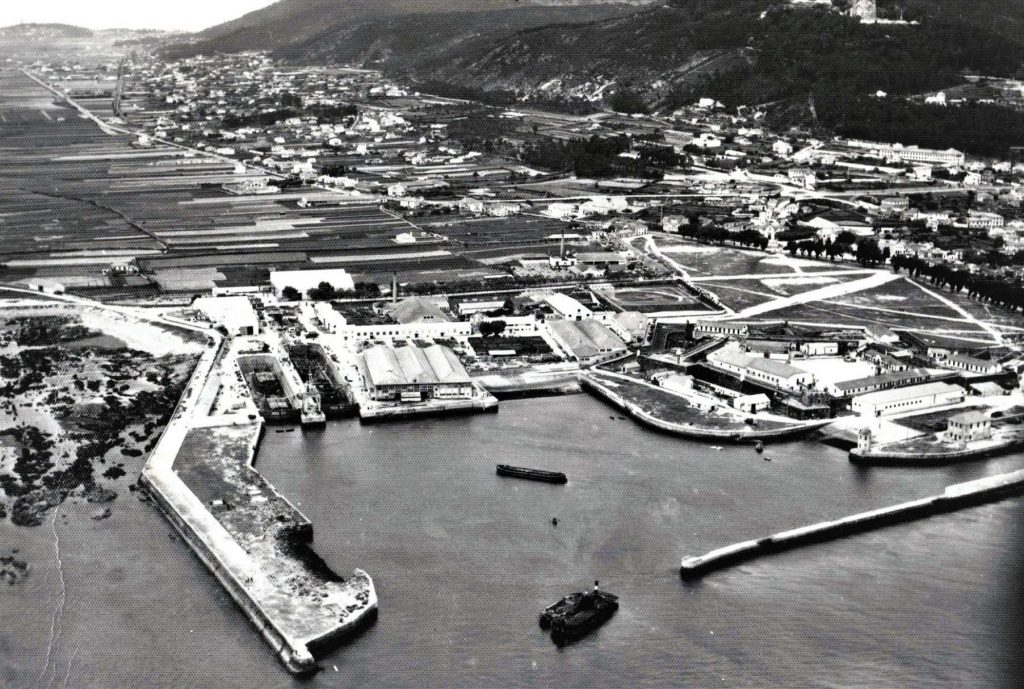
Vista aérea dos Estaleiros Navais de Viana do Castelo. (© Fonte: Gonçalo Fagundes Meira, década de 50).
Aerial view of the Estaleiros Navais de Viana do Castelo. (© Source: Gonçalo Fagundes Meira, década de 50).
Ao implantarem-se num meio rural e de pesca, sem nenhuma tradição industrial, tiveram grandes dificuldades de recrutamento de pessoal minimamente habilitado tendo que recorrer a trabalhadores rurais e artesãos como ferreiros, funileiros, carpinteiros, pintores, etc., das aldeias limítrofes. Uma condicionante de produtividade que se manteve por muitos anos, agravada pela inexistência de quadros técnicos locais ou outros que se quisessem fixar em Viana, para além do núcleo fundador inicial.
Being established in a rural and fishing environment without any industrial tradition, the Shipyard had great difficulties in recruiting minimally qualified personnel, having to resort to rural workers and artisans such as blacksmiths, tinsmiths, carpenters, painters, etc., from the neighbouring villages. This productivity constraint, which remained for many years, was aggravated by the lack of local technical staff or others who wanted to settle in Viana, besides the initial founding group.
Navio Hospital Gil Eannes. (© Fonte: ENVC, SA, 1955).
Gil Eannes Hospital Ship. (© Source: ENVC, SA, 1955).
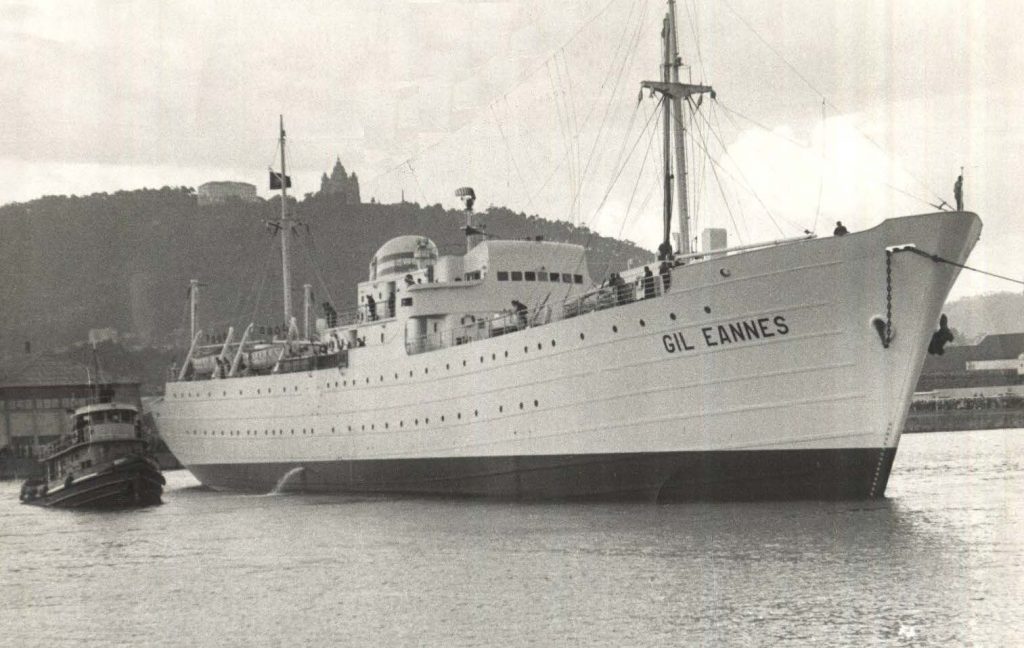
Da segunda geração, mais habilitada, nomeadamente os oriundos das boas Escolas Industriais da altura, surgiram um grande número de excelentes técnicos e operários muito competentes que se salientaram nas principais empresas metalomecânicas do país e também no estrangeiro, quando integrados em empresas com métodos de gestão mais eficientes.
A vertente formativa foi, durante muitos anos, talvez o contributo mais importante dos Estaleiros para a Sociedade e Economia da região.
A second, more skilled generation, mainly those coming from the good industrial schools of that time, became excellent technicians and very skilled workers who stood out in the main metalworking companies in the country and abroad, when integrated into companies with more efficient management methods.
For many years, the educational component was perhaps the most important contribution of the shipyard to the society and economy of the region.
Esquerda: A moldar o aço. (© Carlos Couteiro. Fonte: Gonçalo Fagundes Meira, década de 1970). Direita: A rebitar. (© Fonte: Gonçalo Fagundes Meira, década de 1940).
Left: Shaping steel. (© Carlos Couteiro. Source: Gonçalo Fagundes Meira, 1970s). Right: Riveting. (© Source: Gonçalo Fagundes Meira, 1940s).
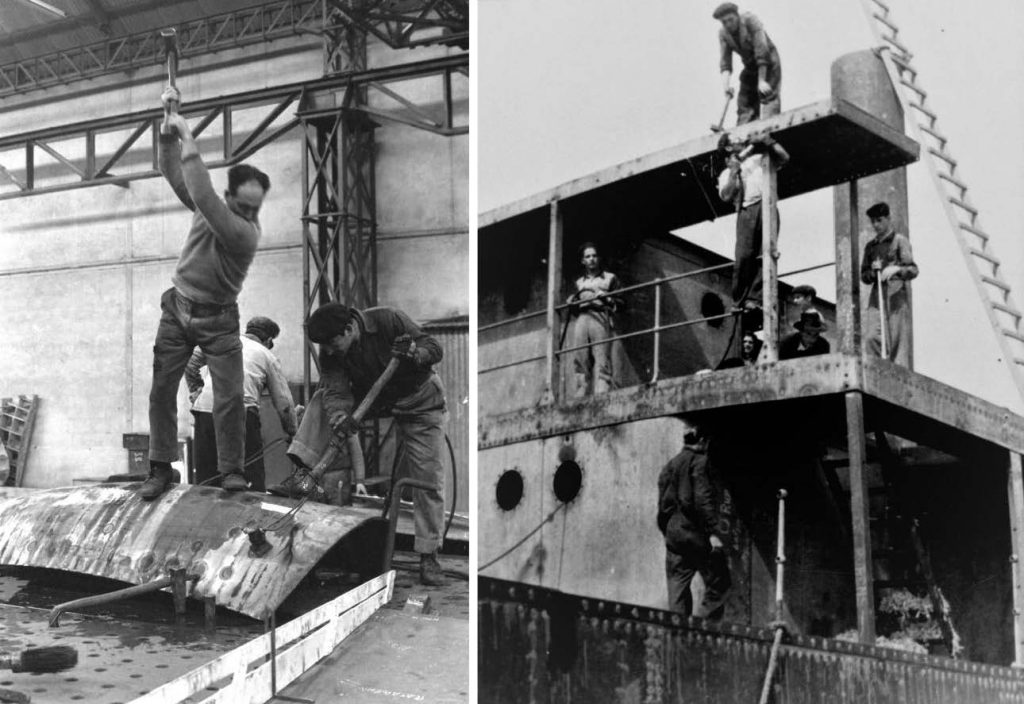
Nas primeiras décadas, os vários factores já referidos e a falta de capacidade de investimento não permitiram criar uma indústria competitiva, com níveis de produtividade equiparáveis aos da concorrência estrangeira. Compensavam-se os deficits de produtividade, com a prática de salários baixos. Quanto à qualidade nada a dizer, os ENVC sempre foram dos melhores, embora com custos que os Armadores, normalmente, não estavam dispostos a pagar.
Em 1971 entrou na estrutura accionista, com a maioria do capital, o Grupo CUF, o maior grupo económico do país, presente em praticamente todos os sectores Industriais e de Serviços, que detinha os Estaleiros da Rocha do Conde D´Óbidos em Lisboa, da Lisnave e da Parry & Son em Almada e da Setenave em Setúbal.
Tinha uma estratégia de outro nível para a Empresa, que passava pela modernização e expansão, com racionalização de “layouts”, investimento em novos equipamentos e introdução de novos processos de gestão e cultura do grupo que eram uma referência no país.
Este processo foi interrompido com a nacionalização da Empresa, na sequência da revolução de Abril de 1974.
Nos anos oitenta, um contrato com a União Soviética que terminou com a desintegração desta, possibilitou a construção de 31 navios, sendo os últimos 6 entregues à Ucrânia e registados em Odessa. Garantiu estabilidade e continuidade de produção com ocupação de cerca de 70% da capacidade durante mais de uma década, o que, aliado a outros bons contratos para o Brasil conduziu a alguns anos de prosperidade, tendo sido inclusivamente distinguidos como a empresa do ano por dois jornais de referência (DN e Expresso) em 84 e 85.
Iniciou-se também nesta década a aposta nas reparações em moldes internacionais, dirigidas principalmente para o mercado europeu, com especial relevância para a Alemanha, Holanda e Dinamarca.
A partir dos anos 90 a situação complicou-se com a deslocalização da construção naval da Europa largamente maioritária até aos anos 70, para a Ásia, numa tendência que tudo leva a crer seja irreversível.
Nos últimos anos, a Europa constrói menos de 10% dos navios, tendo ficado praticamente reduzida aos de alta tecnologia, nomeadamente navios militares e de passageiros e reparações. Os navios constroem-se em qualquer lugar, mas reparam, em regra, nas zonas onde operam.
Durante a sua existência, os ENVC construíram mais de 220 navios de média dimensão, tais como: navios de pesca, de carga geral, ferryboats, porta-contentores, cimenteiros, navios tanques, LPGs, navios químicos e militares e repararam mais de 2 000 navios de todos os tipos. Até aos anos 70 o mercado era nacional e depois maioritariamente internacional, nos últimos 20 anos principalmente o mercado alemão.
A importância relativa dos Estaleiros na cidade e na actividade portuária evoluiu de forma diversa. Nos primeiros 30 anos, sendo a única indústria relevante da região, tinha uma importância enorme na cidade e no concelho, pela quantidade de emprego e pela actividade económica que gerava. No porto de mar, no entanto, a importância era diminuta uma vez que, quase exclusivamente na actividade de construção, pouco movimento gerava com a saída dos navios que construía.
A partir dos anos 80, com a aposta cada vez maior nas reparações, acentuada nos últimos anos, passaram a ter grande importância na actividade do porto com cerca de 120 movimentos anuais, com tudo o que isso implica na pilotagem, nos rebocadores, nos agentes de navegação, na ocupação de cais, etc.
A evolução da mão-de-obra foi notória. Dos 500 a 600 trabalhadores iniciais passou para os 1500 a 1600 nos anos 50 e 60, atingindo os 2000 em meados dos anos 80, quando ainda tinha uma estrutura de produção verticalizada, com pessoal próprio em todas as profissões, salvo duas ou três especializações específicas.
A partir dos anos 90, seguindo a tendência geral, para melhor responder às flutuações do mercado, tão características desta indústria, optaram por uma estrutura cada vez mais horizontal subempreitando parte significativa do trabalho a empresas da região que à sua sombra se foram criando, mantendo assim o número total de trabalhadores da região envolvidos, quer nas instalações dos estaleiros, quer nas diversas oficinas externas, acima dos 1500.
A situação entretanto alterou-se nos últimos anos antes do encerramento, tendo o número de pessoal próprio baixado até aos 609 finais.
Os Estaleiros contribuíram, durante muitos anos, com cerca de 30% do volume emprego e com 40% das remunerações da indústria transformadora do Alto Minho.
Em 2012 o Governo decidiu a iniciar o processo de reprivatização, tendo como objectivo que o Estado deixasse de ter qualquer participação directa ou indirecta no capital social da ENVC.
Não tendo tido sucesso a reprivatização do capital social por venda directa das acções, o processo culminou com a subconcessão ao Grupo Martifer da utilização privativa do domínio público e das áreas afectas à concessão atribuída aos ENVC, o qual, através da nova subsidiária West Sea, assumiu desenvolver a sua actividade no mercado nacional e internacional de construção e reparação naval.
Em maio de 2014, com o início da actividade da West Sea deu-se o renascimento da construção e reparação naval em Viana.
Os primeiros meses foram dedicados à recuperação de infraestruturas e equipamentos que estavam, em muitos casos, em avançado estado de degradação por falta de manutenção há anos descurada. Conseguiu-se com avultado custo financeiro e com a colaboração de ex- trabalhadores dos ENVC, conhecedores das instalações, entretanto contratados.
Paralelamente iniciou-se a actividade comercial de recuperação de clientes que se tinham perdido e em Junho deu entrada na W.S. o primeiro navio para reparação. Até ao fim do ano repararam-se 22 navios.
In the first decades, due to the reasons explained above and to the lack of investment capacity, it was not possible to create a competitive industry with levels of productivity comparable to those of foreign competitors. Productivity deficits were compensated with the practice of low wages. As for the quality, there is nothing to say, ENVC have always been one of the best, even at costs that ship owners normally were unwilling to pay.
In 1971, the CUF Group which is one of the largest economic group in the country with a presence in practically all the industrial and services sectors (Owner of the Rocha do Conde D’Óbidos Shipyard in Lisbon, Lisnave and Parry & Son in Almada and Setenave in Setúbal) took over as the ENVC’s major shareholder.
They had a next-level strategy for the Company which included the modernization and expansion of the shipyard, rationalization of layouts, investment in new equipment and implementation of new management processes and group culture, which by that time was a reference in the country.
However, this process was interrupted with the nationalisation of company, following the Carnation Revolution in April 1974.
In the 1980’s, ENVC signed a contract with the USSR which lasted until the dissolution of the Soviet Union. Under this contract, the Shipyard built 31 ships (the last 6 of which were delivered to Ukraine and registered in Odessa), guaranteeing stability and continuity of production with an occupation of around 70% of the capacity for more than a decade. Also, profitable shipbuilding contracts were signed with Brazil, so the shipyard enjoyed some years of prosperity, having even been distinguished as the Portuguese Company of the Year by two leading newspapers (DN and Expresso) in 1984 and 1985.
In this decade, ENVC also began to expand the repair activity to the international market, mainly to European one, with special relevance to Germany, the Netherlands and Denmark.
After the 1990’s, the situation became more complicated with the relocation of shipbuilding from Europe, which had the largest market share until the 1970s, to Asia, in a trend that apparently seems to be irreversible.
During the recent years, Europe builds less than 10% of ships trading in the world, focus is now put on the market segment of high value added, complex ships, namely military and passenger ships and the repair activity. Ships can be built anywhere, but usually they are repaired in the areas where they trade.
Throughout its existence, more than 220 medium-sized vessels, such as fishing vessels, general cargo vessels, ferries, container ships, cement carriers, tankers, LPGs, chemical and military vessels were built, and more than 2,000 ships of all types were repaired by ENVC. Until the 1970’s the shipyard worked for domestic market only, then it expanded internationally, being the German market the most important one in its last 20 years.
The relative importance of ENVC in the town and local port activity developed in different ways. In the first 30 years, as the only relevant industry in the area, the Shipyard had an enormous importance in the town and in the region due to the quantity of employment and economic growth it generated. In the seaport, however, the impact was negligible. As an almost exclusively shipbuilding yard, little movement was produced by its activity.
From the 1980s onward, the increase of the ship repair activity, reinforced in the last years, provided a boost in the port’s development (with around 120 movements per year) and in its associated services such as pilotage, tugboat services, ship agents, berths occupancy, etc.
The evolution of the workforce was remarkable. From the initial 500 to 600 workers, it increased to 1500 – 1600 in the 1950s and 1960s, reaching 2000 in the mid-1980s, when the shipyard had still a vertical business organisation, with own personnel for most of the fields of expertise.
From 1990 onward, following the general trend, and in order to better respond to market fluctuations so characteristic of this industry, the shipyard opted for an increasingly horizontal structure, subcontracting a significant part of the work to companies in the region that were created in their shadow, thus maintaining the 1500 workers in the region, both in the shipyard and in the different external workshops.
However, the situation changed in the last few years before the Shipyard shutdown, with its own staff reduced to 609.
For many years, ENVC contributed around 30% of the volume of employment and 40% of the remuneration of the manufacturing industry in Alto Minho.
In 2012, the Portuguese Government started the reprivatisation process so that it would no longer have any direct or indirect participation in the share capital of ENVC.
As the reprivatisation of the share capital through the direct sale of shares was not successful, the process culminated in the sub-concession to the Martifer Group for the private use of the public domain and the areas allocated to the concession granted to ENVC, which, through the new West Sea subsidiary, assumed to develop its activity in the national and international shipbuilding and ship repair market.
In May 2014, the rebirth of shipbuilding and ship repair in Viana do Castelo took place when West Sea started its activity.
In the first months, significant effort was put into the recovery of the facilities and equipment that were, in many cases, in an advanced state of degradation due to a long-term lack of maintenance. This was achieved thanks to a considerable financial investment and to the collaboration of former ENVC workers, who were hired in the meantime and were well acquainted with the shipyard facilities.
At the same time, a marketing strategy was outlined to gain regular clients back and to win new ones and, in June, the first repair was awarded to West Sea. By the end of that year, 22 ships were repaired.
Acesso para tanque de LNG. (© Fonte: West Sea, 2020).
Access to LNG tank. (© Source: West Sea, 2020).
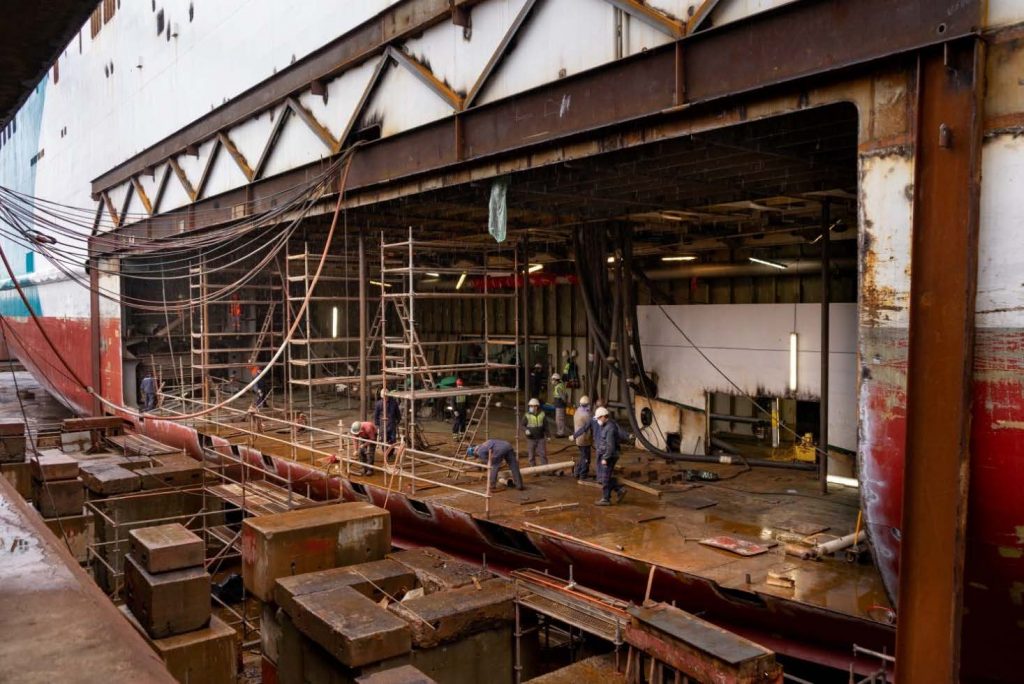
Navio em reparação. (© Fonte: West Sea, 2022).
Ship under repair. (© Source: West Sea, 2022).
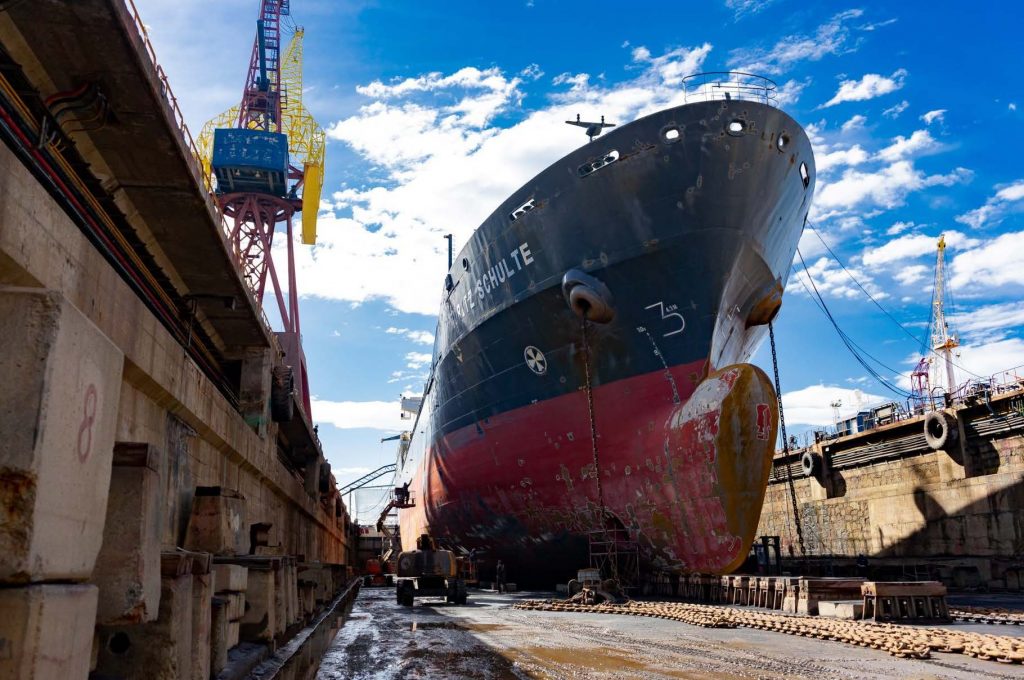
Em Dezembro 2014 assinou-se o primeiro contrato de construção, um navio hotel e de cruzeiros de rio, o primeiro de uma série de 10 navios deste tipo e, em Setembro de 2015, o contrato de construção de dois Navios de Patrulha Oceânica para a marinha portuguesa. São navios que têm como missões principais o patrulhamento da nossa ZEE (Zona Económica Exclusiva), acções de controlo das pescas, busca e salvamento, controlo da imigração ilegal, assistência a populações em situações de catástrofe e também capacidade para cooperar em acções militares.
In December 2014, the first shipbuilding contract for a hotel and river cruise ship was signed, the first of a series of 10 ships of this type. In September 2015, another contract was signed with the Portuguese Navy for the construction of 2 Ocean Patrol Vessels. These vessels are designed to reinforce the Patrol and Surveillance of the Portuguese Exclusive Economic Zone (EEZ), ensuring the control of maritime spaces under national sovereignty and jurisdiction. They are also important to comply with international commitments taken by the Portuguese State, regarding safeguarding human life at sea and maritime search and rescue.
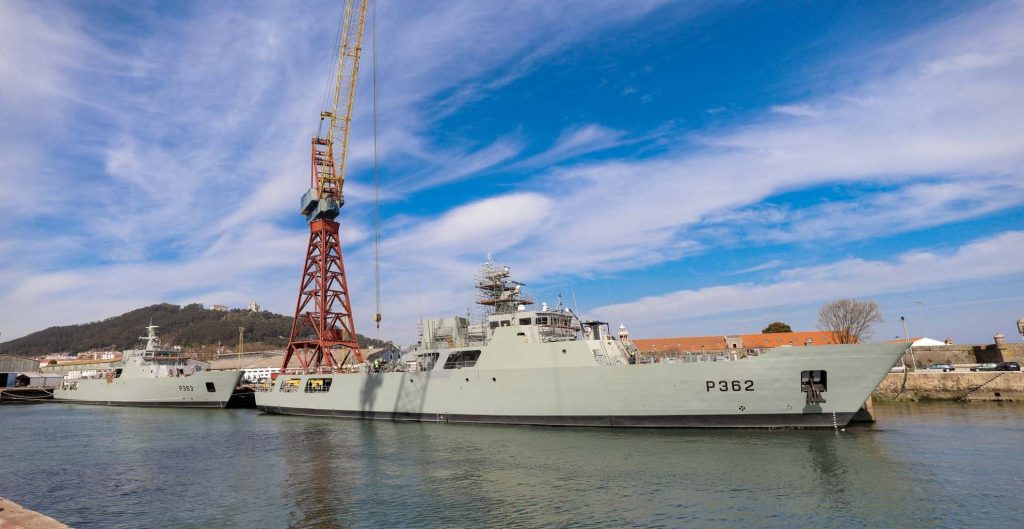
Navios Patrulha na fase final de construção. (© Fonte: West Sea, 2018).
Patrol ship in the final stage of construction. (© Source: West Sea, 2018).
Navio Hotel “Viking Osfrid”. (© Fonte: West Sea, 2016).
Hotel Ship “Viking Osfrid”. (© Source: West Sea, 2016).
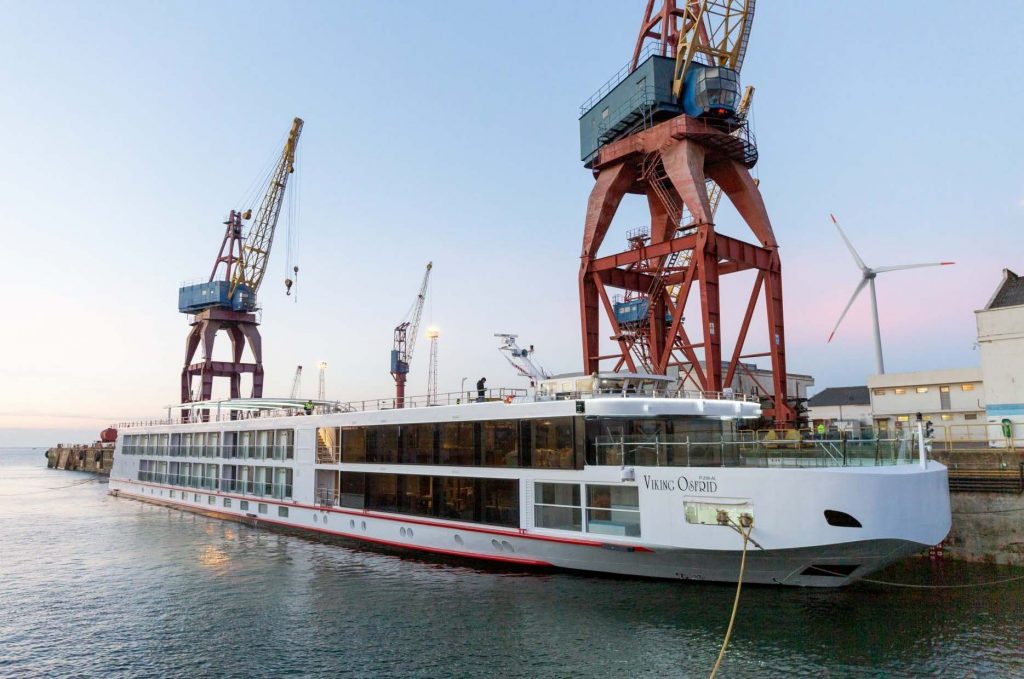
Em Junho de 2017 foi assinado o contrato de construção do primeiro navio de expedição polar de uma série 3 já entregue e outros 3 em construção. São navios de luxo e aventura, “Ice” classe, com capacidade para 200 passageiros e 112 tripulantes, dirigidos a um público-alvo diferente do dos grandes paquetes, para operar no Árctico, Antárctida e Fiordes Noruegueses e representam um salto qualitativo importante, para um tipo de navios nunca antes construídos em Portugal.
In June 2017, a contract for the construction of 6 first polar expedition ships was signed. Three of them have already been delivered and the other three are currently under construction. They are special ice class ships made for luxury and adventure cruising holidays in polar regions (Arctic and Antarctic regions and Norwegian Fjords), with a capacity for 200 passengers and 112 crew, and their target clients are different from those of mega cruise ships. They represent an important qualitative leap for a type of ship which has never been built in Portugal.
Navio de expedição polar “World Navigator”. (© Fonte: West Sea, 2021).
Polar expedition ship “World Navigator”. (© Source: West Sea, 2021).
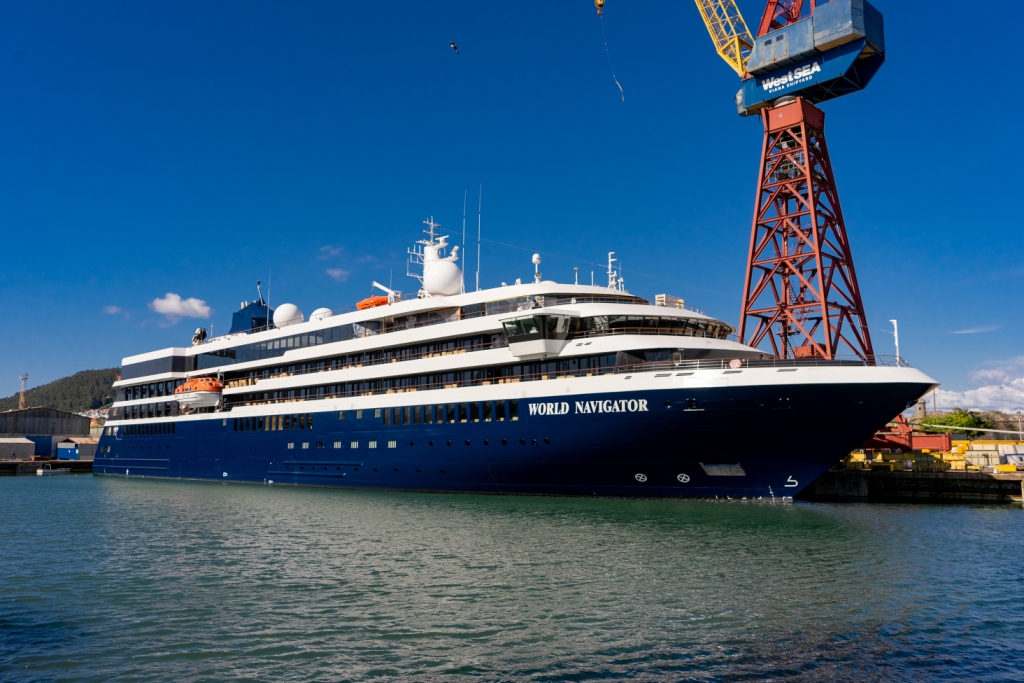
Em 2017, construiu-se uma draga de sucção para um armador português.
Até 2021 construíram-se 17 e repararam-se 283 navios.
O número de colaboradores próprios é de 380, sendo a média nas instalações da W.S., incluindo subempreiteiros, superior a 1000/dia, acrescido de mais centena e meia nas diversas oficinas da área que lhe dão apoio.
O plano estratégico do Grupo Martifer para a área naval, aposta em segmentos de construção em que pela experiência e conhecimentos adquiridos a W.S. possa ser competitiva, como é o caso de navios militares e navios de cruzeiro e também na construção de outros produtos e equipamentos que pela sua dimensão e pela ligação da West Sea ao Grupo, possam vir a ser construídos em espaço de estaleiro.
Para aumentar a capacidade de reparação, posicionando-se como um dos mais importantes estaleiros da Europa nesta área, vai investir mais de 20 milhões de euros na construção de uma nova doca de maiores dimensões e maior calado, 220m X 45m X 7,5m, agora possível com o recente aprofundamento do canal de acesso, permitindo reparar navios até 60 000 DWT.
During that year, a suction dredger was also built for a Portuguese owner.
Until 2021, 17 ships have been built and 283 ships have been repaired.
West Sea has 380 direct employees, however an average of more than 1000 people per day, subcontractors included, are working in the shipyard, plus over 150 from the various local workshops.
The Martifer Group’s strategic plan for the shipping area is focused on thriving in niche markets where West Sea can be competitive with the long expertise and technical knowledge acquired, such as naval and cruise ships and also the construction of other products and equipment that, due to their size and in the cooperation with other Martifer group companies, can be built in the shipyard facilities.
Also, the Martifer Group is going to invest more than 20 million euros in the construction of a new dock with larger dimensions and a greater draft (220m X 45m X 7,50 m), now possible with the recent deepening of the shipyard’s access channel. This will increase the repair capacity, allowing the docking of ships up to 60,000 DWT, and will position West Sea Shipyard as one of the most important shipyards in West Europe.
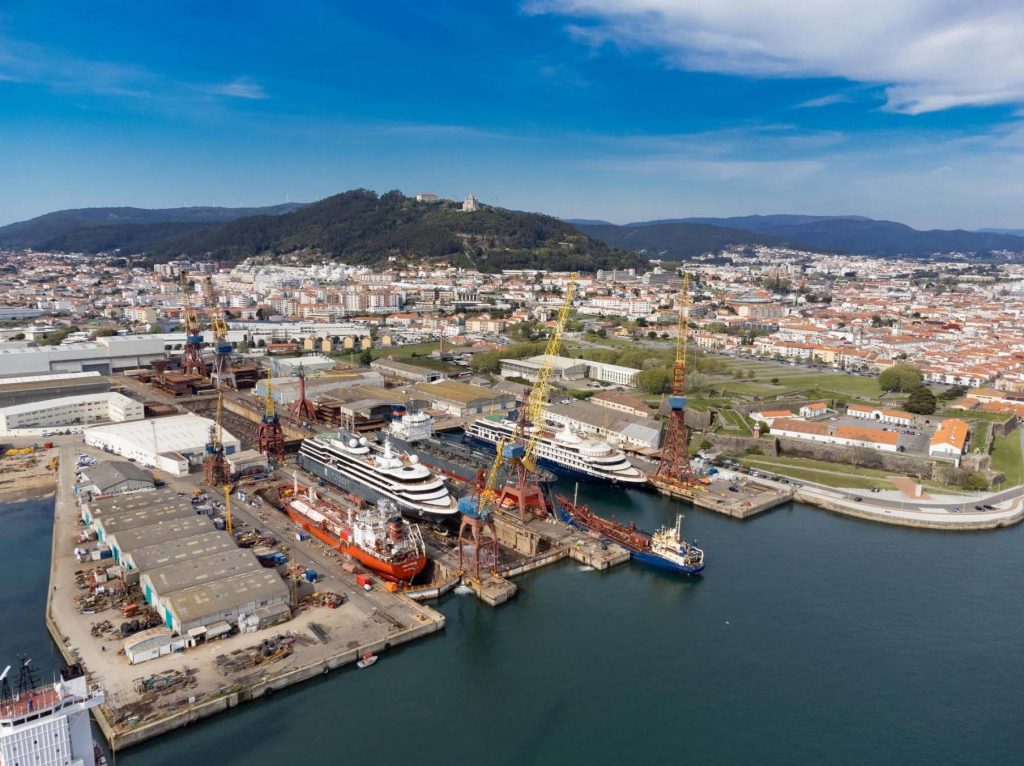
Vista aérea dos Estaleiros Navais West Sea. (© Fonte: West Sea, 2022).
Aerial view of the Estaleiros Navais West Sea. (© Source: West Sea, 2022).
IMAGEM INICIAL | Navios em construção e em reparação. (© Fonte: West Sea, 2021).
HEAD IMAGE | Ships under construction and repair. (© Source: West Sea, 2021).